2013 Peugeot 807 seats
[x] Cancel search: seatsPage 95 of 234
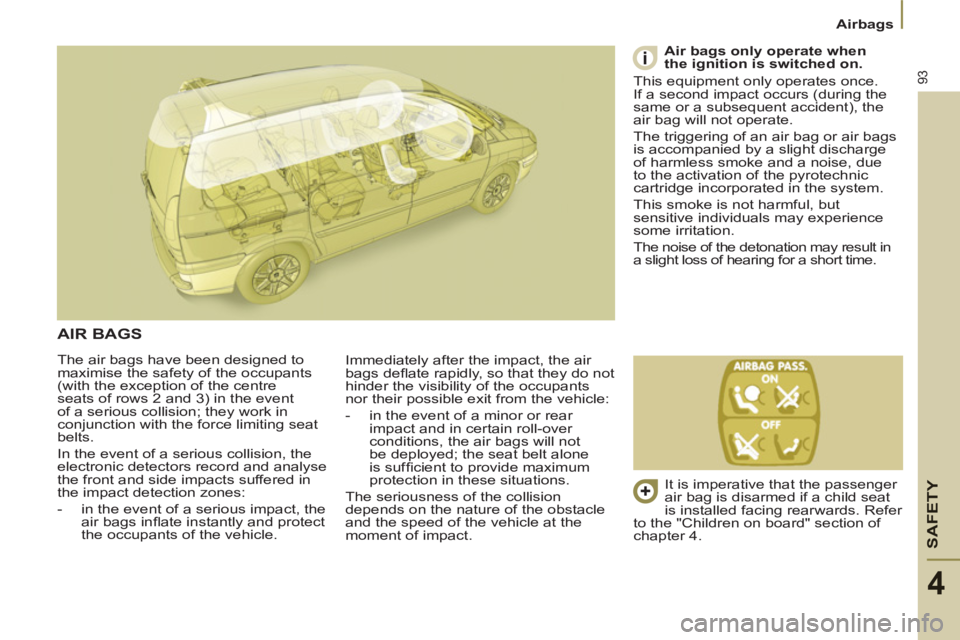
SAFETY
93
Airbags
4
The air bags have been designed to
maximise the safety of the occupants
(with the exception of the centre
seats of rows 2 and 3) in the event
of a serious collision; they work in
conjunction with the force limiting seat
belts.
In the event of a serious collision, the
electronic detectors record and analyse
the front and side impacts suffered in
the impact detection zones:
- in the event of a serious impact, the
air bags infl ate instantly and protect
the occupants of the vehicle. Immediately after the impact, the air
bags defl ate rapidly, so that they do not
hinder the visibility of the occupants
nor their possible exit from the vehicle:
- in the event of a minor or rear
impact and in certain roll-over
conditions, the air bags will not
be deployed; the seat belt alone
is suffi cient to provide maximum
protection in these situations.
The seriousness of the collision
depends on the nature of the obstacle
and the speed of the vehicle at the
moment of impact.
Air bags only operate when
the ignition is switched on.
This equipment only operates once.
If a second impact occurs (during the
same or a subsequent accident), the
air bag will not operate.
The triggering of an air bag or air bags
is accompanied by a slight discharge
of harmless smoke and a noise, due
to the activation of the pyrotechnic
cartridge incorporated in the system.
This smoke is not harmful, but
sensitive individuals may experience
some irritation.
The noise of the detonation may result in
a slight loss of hearing for a short time.
AIR BAGS
It is imperative that the passenger
air bag is disarmed if a child seat
is installed facing rearwards. Refer
to the "Children on board" section of
chapter 4.
Page 96 of 234
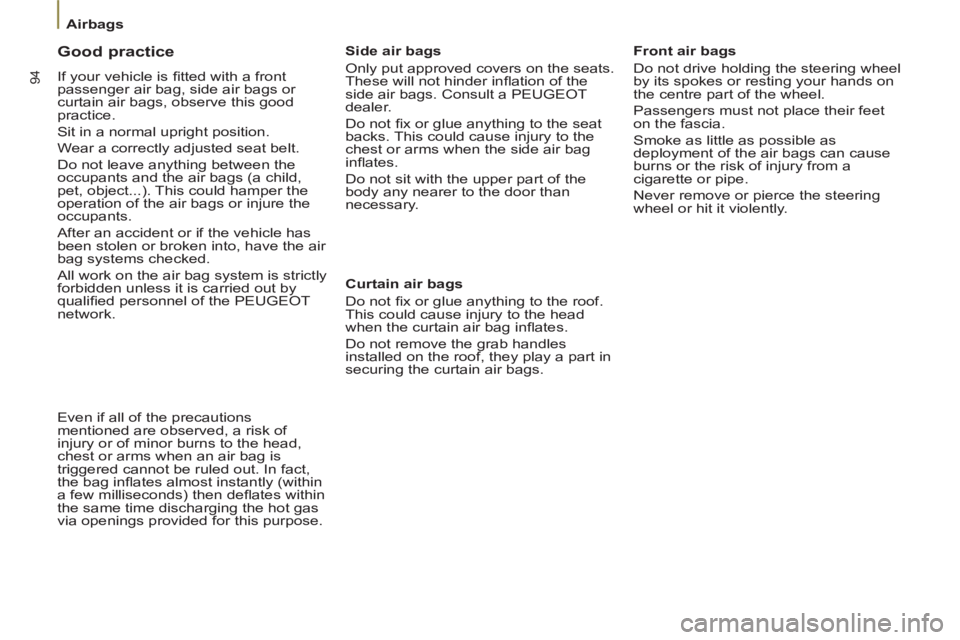
94
Airbags
Good practice
If your vehicle is fi tted with a front
passenger air bag, side air bags or
curtain air bags, observe this good
practice.
Sit in a normal upright position.
Wear a correctly adjusted seat belt.
Do not leave anything between the
occupants and the air bags (a child,
pet, object...). This could hamper the
operation of the air bags or injure the
occupants.
After an accident or if the vehicle has
been stolen or broken into, have the air
bag systems checked.
All work on the air bag system is strictly
forbidden unless it is carried out by
qualifi ed personnel of the PEUGEOT
network.
Front air bags
Do not drive holding the steering wheel
by its spokes or resting your hands on
the centre part of the wheel.
Passengers must not place their feet
on the fascia.
Smoke as little as possible as
deployment of the air bags can cause
burns or the risk of injury from a
cigarette or pipe.
Never remove or pierce the steering
wheel or hit it violently.
Side air bags
Only put approved covers on the seats.
These will not hinder infl ation of the
side air bags. Consult a PEUGEOT
dealer.
Do not fi x or glue anything to the seat
backs. This could cause injury to the
chest or arms when the side air bag
infl ates.
Do not sit with the upper part of the
body any nearer to the door than
necessary.
Curtain air bags
Do not fi x or glue anything to the roof.
This could cause injury to the head
when the curtain air bag infl ates.
Do not remove the grab handles
installed on the roof, they play a part in
securing the curtain air bags.
Even if all of the precautions
mentioned are observed, a risk of
injury or of minor burns to the head,
chest or arms when an air bag is
triggered cannot be ruled out. In fact,
the bag infl ates almost instantly (within
a few milliseconds) then defl ates within
the same time discharging the hot gas
via openings provided for this purpose.
Page 97 of 234
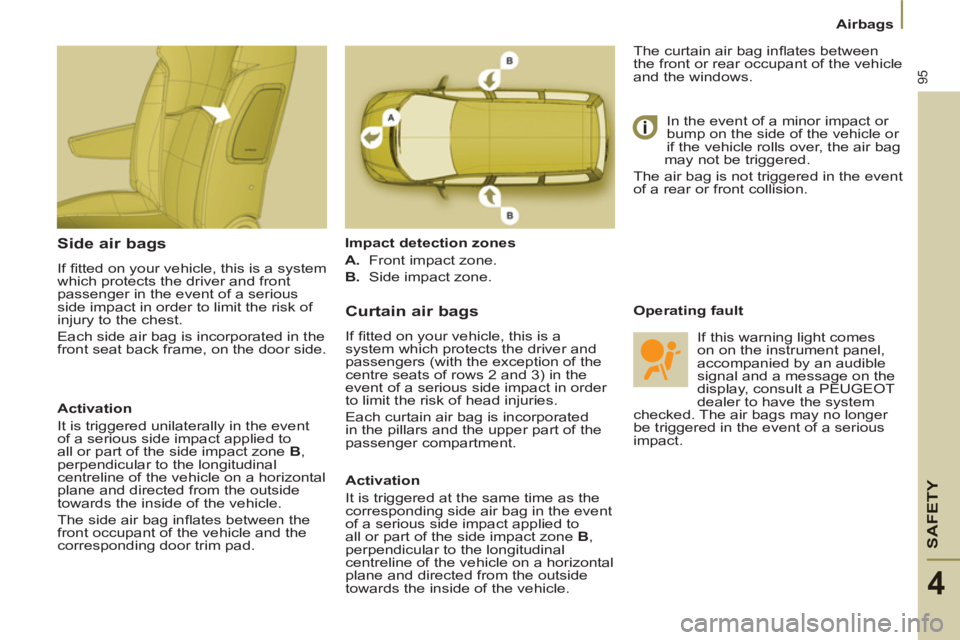
SAFETY
95
Airbags
4
Side air bags
If fi tted on your vehicle, this is a system
which protects the driver and front
passenger in the event of a serious
side impact in order to limit the risk of
injury to the chest.
Each side air bag is incorporated in the
front seat back frame, on the door side. The curtain air bag infl ates between
the front or rear occupant of the vehicle
and the windows.
Impact detection zones
A.
Front impact zone.
B.
Side impact zone.
In the event of a minor impact or
bump on the side of the vehicle or
if the vehicle rolls over, the air bag
may not be triggered.
The air bag is not triggered in the event
of a rear or front collision.
Operating fault
Curtain air bags
If fi tted on your vehicle, this is a
system which protects the driver and
passengers (with the exception of the
centre seats of rows 2 and 3) in the
event of a serious side impact in order
to limit the risk of head injuries.
Each curtain air bag is incorporated
in the pillars and the upper part of the
passenger compartment.
Activation
It is triggered unilaterally in the event
of a serious side impact applied to
all or part of the side impact zone B
,
perpendicular to the longitudinal
centreline of the vehicle on a horizontal
plane and directed from the outside
towards the inside of the vehicle.
The side air bag infl ates between the
front occupant of the vehicle and the
corresponding door trim pad.
Activation
It is triggered at the same time as the
corresponding side air bag in the event
of a serious side impact applied to
all or part of the side impact zone B
,
perpendicular to the longitudinal
centreline of the vehicle on a horizontal
plane and directed from the outside
towards the inside of the vehicle. If this warning light comes
on on the instrument panel,
accompanied by an audible
signal and a message on the
display, consult a PEUGEOT
dealer to have the system
checked. The air bags may no longer
be triggered in the event of a serious
impact.
Page 99 of 234
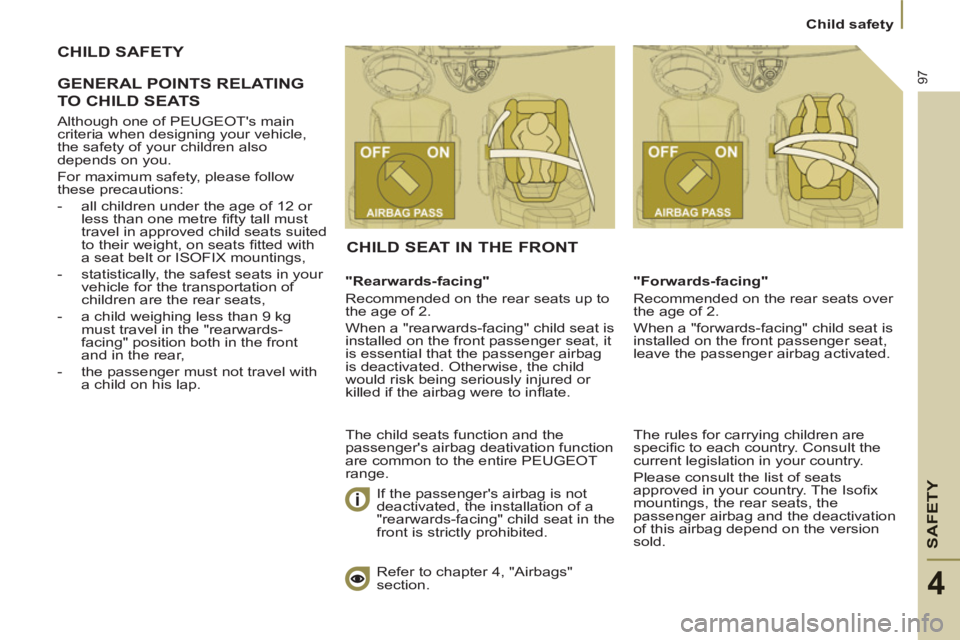
SAFETY
97
Child safety
4
CHILD SAFETY
GENERAL POINT
S RELATING
TO CHILD SEATS
"Rearwards-facing"
Recommended on the rear seats up to
the age of 2.
When a "rearwards-facing" child seat is
installed on the front passenger seat, it
is essential that the passenger airbag
is deactivated. Otherwise, the child
would risk being seriously injured or
killed if the airbag were to infl ate.
"Forwards-facing"
Recommended on the rear seats over
the age of 2.
When a "forwards-facing" child seat is
installed on the front passenger seat,
leave the passenger airbag activated.
CHILD SEAT IN THE FRONT
The rules for carrying children are
specifi c to each country. Consult the
current legislation in your country.
Please consult the list of seats
approved in your country. The Isofi x
mountings, the rear seats, the
passenger airbag and the deactivation
of this airbag depend on the version
sold.
The child seats function and the
passenger's airbag deativation function
are common to the entire PEUGEOT
range.
Although one of PEUGEOT's main
criteria when designing your vehicle,
the safety of your children also
depends on you.
For maximum safety, please follow
these precautions:
- all children under the age of 12 or
less than one metre fi fty tall must
travel in approved child seats suited
to their weight, on seats fi tted with
a seat belt or ISOFIX mountings,
- statistically, the safest seats in your
vehicle for the transportation of
children are the rear seats,
- a child weighing less than 9 kg
must travel in the "rearwards-
facing" position both in the front
and in the rear,
- the passenger must not travel with
a child on his lap.
Refer to chapter 4, "Airbags"
section.
If the passenger's airbag is not
deactivated, the installation of a
"rearwards-facing" child seat in the
front is strictly prohibited.
Page 100 of 234
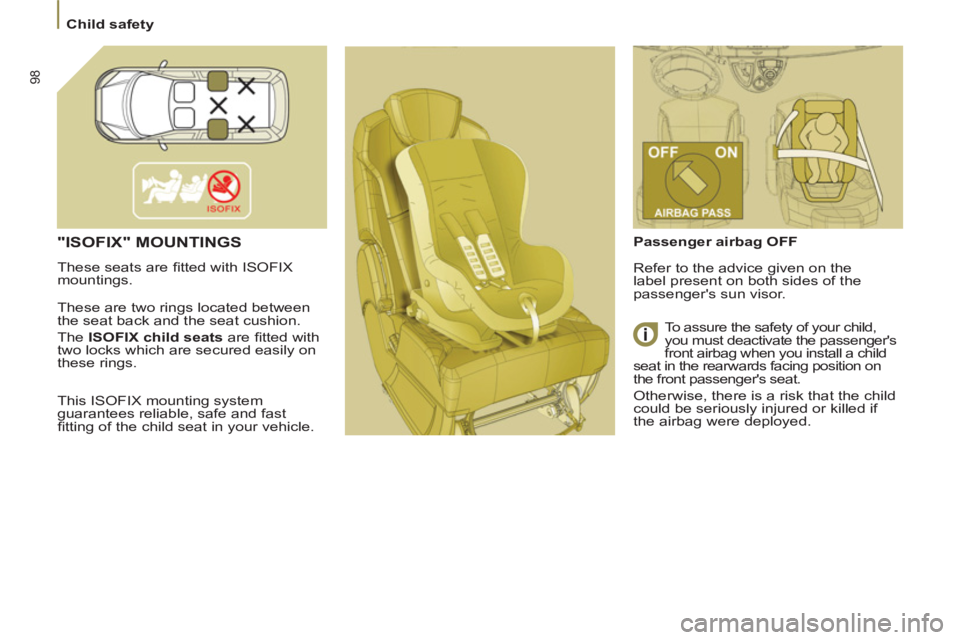
98
Child safety
"ISOFIX" MOUNTINGS
These seats are fi tted with ISOFIX
mountings.
These are two rings located between
the seat back and the seat cushion.
The ISOFIX child seats
are fi tted with
two locks which are secured easily on
these rings.
This ISOFIX mounting system
guarantees reliable, safe and fast
fi tting of the child seat in your vehicle.
Passenger airbag OFF
Refer to the advice given on the
label present on both sides of the
passenger's sun visor.
To assure the safety of your child,
you must deactivate the passenger's
front airbag when you install a child
seat in the rearwards facing position on
the front passenger's seat.
Otherwise, there is a risk that the child
could be seriously injured or killed if
the airbag were deployed.
Page 101 of 234
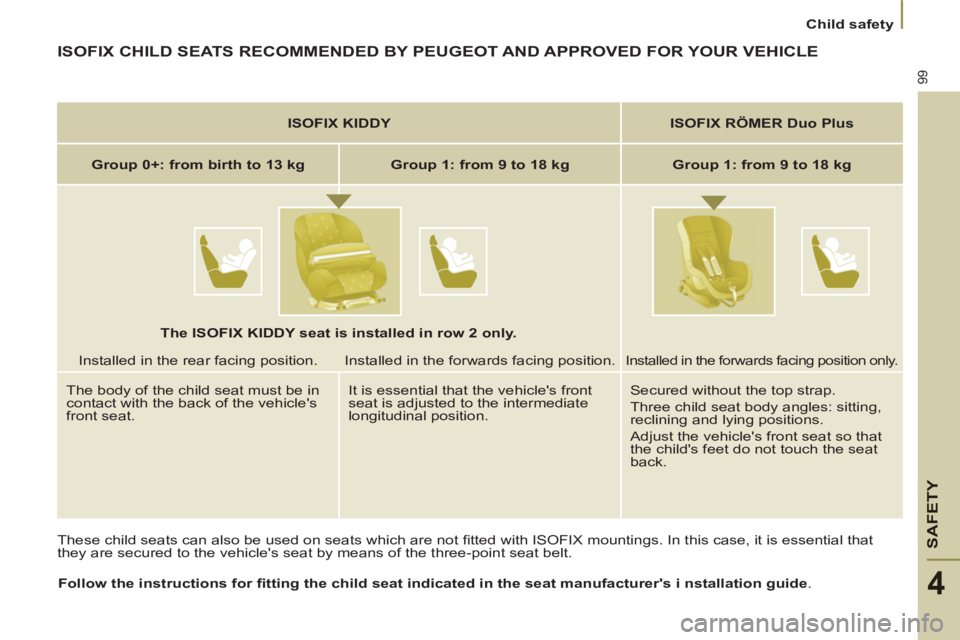
SAFETY
99
Child safety
4
ISOFIX CHILD SEATS RECOMMENDED BY PEUGEOT AND APPROVED FOR YOUR VEHICLE
These child seats can also be used on seats which are not fi tted with ISOFIX mountings. In this case, it is essential that
they are secured to the vehicle's seat by means of the three-point seat belt.
Follow the instructions for fi tting the child seat indicated in the seat manufacturer's i
nstallation guide
.
ISOFIX KIDDY
ISOFIX RÖMER Duo Plus
Group 0+: from birth to 13 kg
Group 1: from 9 to 18 kg
Group 1: from 9 to 18 kg
Installed in the rear facing position. Installed in the forwards facing position.
Installed in the forwards facing position only.
The body of the child seat must be in
contact with the back of the vehicle's
front seat. It is essential that the vehicle's front
seat is adjusted to the intermediate
longitudinal position. Secured without the top strap.
Three child seat body angles: sitting,
reclining and lying positions.
Adjust the vehicle's front seat so that
the child's feet do not touch the seat
back.
The ISOFIX KIDDY seat is installed in row 2 only.
Page 102 of 234
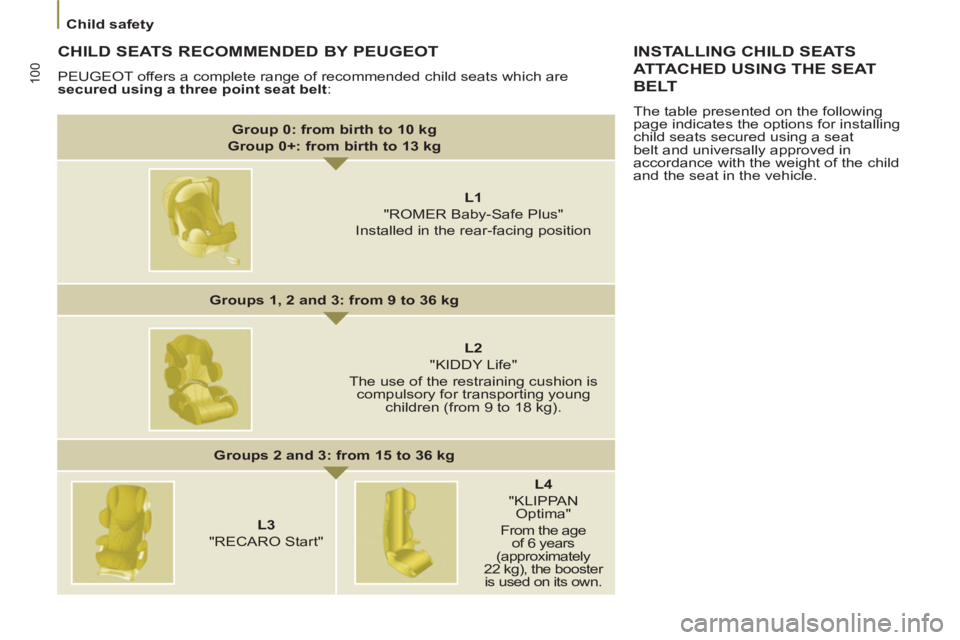
100
Child safety
CHILD SEATS RECOMMENDED BY PEUGEOT
PEUGEOT offers a complete range of recommended child seats which are
secured using a three point seat belt
:
INSTALLING CHILD SEATS
ATTACHED USING THE SEAT
BELT
The table presented on the following
page indicates the options for installing
child seats secured using a seat
belt and universally approved in
accordance with the weight of the child
and the seat in the vehicle.
Group 0: from birth to 10 kg
Group 0+: from birth to 13 kg
L1
"ROMER Baby-Safe Plus"
Installed in the rear-facing position
Groups 1, 2 and 3: from 9 to 36 kg
L2
"KIDDY Life"
The use of the restraining cushion is
compulsory for transporting young
children (from 9 to 18 kg).
Groups 2 and 3: from 15 to 36 kg
L3
"RECARO Start''
L4
"KLIPPAN
Optima"
From the age
of 6 years
(approximately
22 kg), the booster
is used on its own.
Page 103 of 234
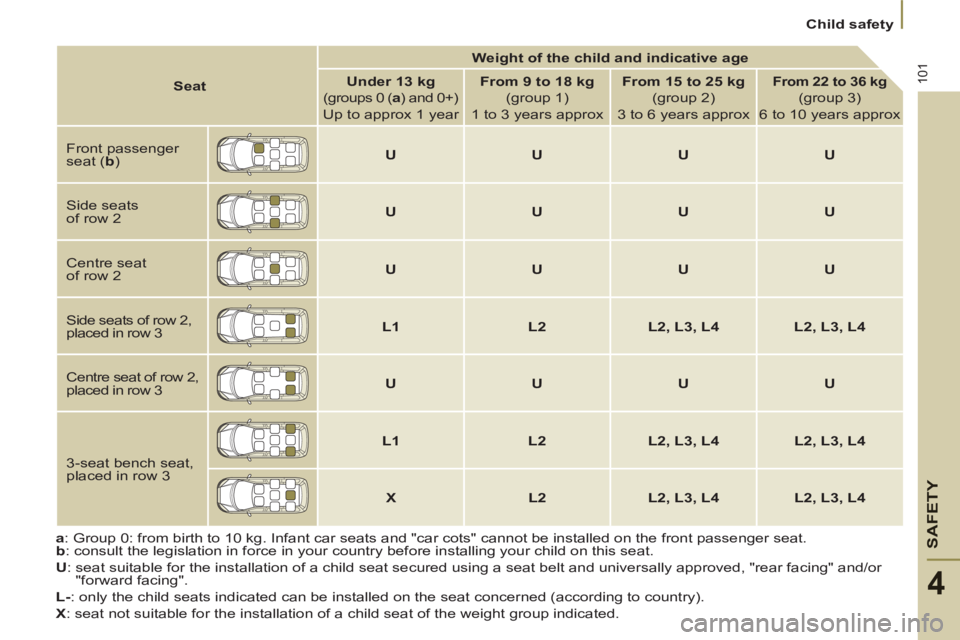
SAFETY
101
Child safety
4
a
: Group 0: from birth to 10 kg. Infant car seats and "car cots" cannot be installed on the front passenger seat.
b
: consult the legislation in force in your country before installing your child on this seat.
U
: seat suitable for the installation of a child seat secured using a seat belt and universally approved, "rear facing" and/or
"forward facing".
L-
: only the child seats indicated can be installed on the seat concerned (according to country).
X
: seat not suitable for the installation of a child seat of the weight group indicated.
Seat
Weight of the child and indicative age
Under 13 kg
(groups 0 ( a
) and 0+)
Up to approx 1 year
From 9 to 18 kg
(group 1)
1 to 3 years approx
From 15 to 25 kg
(group 2)
3 to 6 years approx
From 22 to 36 kg
(group 3)
6 to 10 years approx
Front passenger
seat ( b
)
U
U
U
U
Side seats
of row 2
U
U
U
U
Centre seat
of row 2
U
U
U
U
Side seats of row 2,
placed in row 3
L1
L2
L2, L3, L4
L2, L3, L4
Centre seat of row 2,
placed in row 3
U
U
U
U
3-seat bench seat,
placed in row 3
L1
L2
L2, L3, L4
L2, L3, L4
X
L2
L2, L3, L4
L2, L3, L4